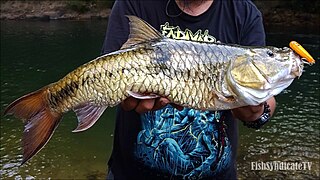
A tuna is a saltwater fish that belongs to the tribe Thunnini, a subgrouping of the Scombridae (mackerel) family. The Thunnini comprise 15 species across five genera, the sizes of which vary greatly, ranging from the bullet tuna up to the Atlantic bluefin tuna, which averages 2 m (6.6 ft) and is believed to live up to 50 years.

Mackerel is a common name applied to a number of different species of pelagic fish, mostly from the family Scombridae. They are found in both temperate and tropical seas, mostly living along the coast or offshore in the oceanic environment.

Herring are various species of forage fish, belonging to the order Clupeiformes.

Tilapia is the common name for nearly a hundred species of cichlid fish from the coelotilapine, coptodonine, heterotilapine, oreochromine, pelmatolapiine, and tilapiine tribes, with the economically most important species placed in the Coptodonini and Oreochromini. Tilapia are mainly freshwater fish inhabiting shallow streams, ponds, rivers, and lakes, and less commonly found living in brackish water. Historically, they have been of major importance in artisanal fishing in Africa, and they are of increasing importance in aquaculture and aquaponics. Tilapia can become a problematic invasive species in new warm-water habitats such as Australia, whether deliberately or accidentally introduced, but generally not in temperate climates due to their inability to survive in cold water.

The International Union for Conservation of Nature (IUCN) Red List of Threatened Species, also known as the IUCN Red List or Red Data Book, founded in 1964, is an inventory of the global conservation status and extinction risk of biological species. A series of Regional Red Lists, which assess the risk of extinction to species within a political management unit, are also produced by countries and organizations.

Sardine and pilchard are common names for various species of small, oily forage fish in the herring suborder Clupeoidei. The term 'sardine' was first used in English during the early 15th century; a somewhat dubious etymology says it comes from the Italian island of Sardinia, around which sardines were once supposedly abundant.

Sprat is the common name applied to a group of forage fish belonging to the genus Sprattus in the family Clupeidae. The term also is applied to a number of other small sprat-like forage fish. Like most forage fishes, sprats are highly active, small, oily fish. They travel in large schools with other fish and swim continuously throughout the day.
The conservation status of a group of organisms indicates whether the group still exists and how likely the group is to become extinct in the near future. Many factors are taken into account when assessing conservation status: not simply the number of individuals remaining, but the overall increase or decrease in the population over time, breeding success rates, and known threats. Various systems of conservation status are in use at international, multi-country, national and local levels, as well as for consumer use such as sustainable seafood advisory lists and certification. The two international systems are by the International Union for Conservation of Nature (IUCN) and The Convention on International Trade in Endangered Species of Wild Fauna and Flora (CITES).

The Saldanha catshark is a species of shark belonging to the family Pentanchidae, the deepwater catsharks. This catshark is found from Cape Columbine to south of False Bay in South Africa, between 31 and 40°S. Its length is up to 88 cm (35 in). It is a plain, dark grey-brown, stout catshark, with moderately large eyes, a broad snout, and large pectoral fins.

An anchovy is a small, common forage fish of the family Engraulidae. Most species are found in marine waters, but several will enter brackish water, and some in South America are restricted to fresh water.

Luciosoma is a genus of freshwater ray-finned fish belonging to the family Danionidae, the danionins or danios. The fishes in this genus are found in Southeast Asia

Shark minnow is a species of small ray-finned fish belonging to the family Danionidae. This fish is found in Southeast Asia from the Mae Klong River to the Mekong. It lives mainly in rivers, moving into flooded forests and fields during the floods and back into the river as the floods recede. It usually swims close to the surface in schools of many individuals. It is one of the most abundant of the different types of minnow-sized fishes known as pla sio in Thailand.
Luciosoma pellegrinii is a species of freshwater ray-finned fish belonging to the family Danionidae, the danios or danionins. This fish is endemic to northeastern and eastern Borneo.
The Apollo sharkminnow species of freshwater ray-finned fish belonging to the family Danionidae, the danios or danionins. This fish is found in Thailand, Sumatra and Borneo.
Luciosoma trinema is a species of freshwater ray-finned fish belonging to the family Danionidae, the danios or danionins. This fish is found on the Malay Peninsula, Sumatra and Borneo.

Hampala sabana is a species of cyprinid in the genus Hampala that is native to Malaysia

Cenchrus setiger, the birdwood grass, is a species in the grass family Poaceae. It native to drier parts of Africa, the Arabian Peninsula, Iran, India, and as far as Myanmar, and has been introduced to the United States, Brazil, and Australia. Drought-tolerant and quite palatable to livestock, it is a valuable fodder and forage in areas that get as little as 200 mm of rain per year, but its productivity is low.














